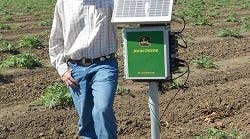Modern agriculture isn’t tethered to past practices, so it shouldn’t surprise anyone that experiments in wireless communication are as likely to occur at the farm level before migrating down the supply chain to production facilities.
Production manager Chris Drew of Ocean Mist Farms stands next to a soil-monitoring device that uploads information on moisture, salinity and other factors to a mid-orbit satellite, then back to Ocean Mist’s.
Field Connect is a case in point. Originally dubbed CropSense before the technology was acquired by Deere & Co., the solar-powered units collect data on soil temperature, moisture levels, electric conductivity (as a salinity indicator) and other variables through ground sensors connected by cable to the unit. It uploads the data every 15 minutes to a low-orbit satellite, which in turn batches it back to Earth to a John Deere data center, where it’s consolidated and relayed to clients like Ocean Mist Farms in Castroville, Calif.
At the recommendation of Ocean Mist’s Chris Drew, production manager-artichokes, the Salinas Valley produce firm became a beta test site for the technology in 2012. Early involvement gave Drew input in shaping how summary graphs and other data are presented. For example, sensors monitor soil moisture to a depth of 40 inches. Daily depletion is calculated, and Drew receives an email alert when replenishment is needed, freeing him and his staff for other tasks in the meantime.
Before the technology was deployed, Ocean Mist used a tensiometer to measure soil moisture, but the wireless technology is more accurate. More importantly, Drew points out, is the 24/7 monitoring the system provides. Dispatching personnel to a remote field during inclement weather or time crunches can result in spotty measurements. The sensors and satellites reliably collect data regardless of conditions. With the valley receiving half its normal rainfall in recent years, Ocean Mist avoids over-watering and is able to optimize fertilizer delivery.
Beyond fresh produce and in-plant monitoring of utilities such as compressed air and water consumption, however, wireless networks still struggle to get a foothold in food & beverage production. Part of the reason is the physical environment: Electronic noise and walls and other barriers can disrupt signal transmission, making wireless a nonstarter for machine motion control.
Another factor is the ready access to electric connections in the typical facility, resulting in hybrid systems that send radio signals but are hard wired. “In food, wireless often isn’t wireless,” observes Ola Westrom, senior industry manager-food & beverage at Endress+Hauser USA, Greenwood, Ind.
“Anything you can do over wired Ethernet, you can do wirelessly,” insists Divya Venkataraman, wireless product manager for Rockwell Automation Inc., Milwaukee. “There are a lot of reliability and security concerns, but there also are opportunities.”
The automotive industry is taking the lead on wireless adoption, she notes, and the entertainment industry, where equipment mobility is necessary when production crews move from location to location, is moving forward.
Field workers still carry canestas when harvesting artichokes in California’s Salinas Valley, but wireless-enabled hi tech is part of the growing process.
Data encryption and authentication of devices interacting with the network are addressed in IEEE 802.11, a wireless standard that is being widely adopted. Still, designing and maintaining a secure wireless network requires a level of expertise often absent in today’s manufacturing environments.
“It’s going to be an ongoing challenge,” acknowledges Tony Baker, Rockwell’s security leader. Identifying a controls engineer or IT professional who can support the infrastructure might be the solution, but an advanced level of expertise will be needed in either case, either in the implementation of necessary protocols for the former or a new appreciation of the particular needs of manufacturing for the latter.
Dialing for data
Mission-critical applications such as machine motion control and safety systems are not candidates for wireless networks, points out John Kowal, business development manager at B&R Industrial Automation Corp. in Roswell, Ga. Virtual network computing (VNC), on the other hand, already is enabling wireless machine set-up and diagnostics of equipment, and while it’s more likely to be found in chemical processing and water-treatment plants where line of sight isn’t important and wiring costs are high, it’s slowly making inroads in food and other industries.
VNC is the enabling technology behind B&R’s System Diagnostic Manager, a software tool the company embeds in its industrial controls. Using a web browser and a tablet or smart phone, an individual can access the software to configure the machine, diagnose run-time problems or monitor operating states.
“You could take control of the machine, but people don’t do that,” says Kowal. Instead, data are securely extracted and downloaded to a file or USB stick for analysis. No inbound transmission of data occurs.
That kind of telemetry functions at a higher level than the simple device connectivity in garden variety wireless networks, but it is helping lay the groundwork for options to wired communication. Such a change is a matter of when, not if. For several years, cable supplier Belden has been steadily adding and divesting business units as it repositions itself as a connectivity provider.
Batteries are the go-to option for powering wireless devices, although finite battery life poses its own challenges when sensors are placed in hard-to-access places. Considerable research is ongoing for alternatives, including photovoltaic systems that convert light to energy, thermo-electric devices that run off of waste heat and low-power motion technology that converts vibration or pressure ripples in a hydraulic line to generate energy.
Regardless of the power option or the application, wireless sensing will eventually find a niche in the food production environment. The evolution is occurring, more slowly than some would hope, but gradually the obstacles are being removed. After all, it worked for NASA, why not for brewing or baking?


